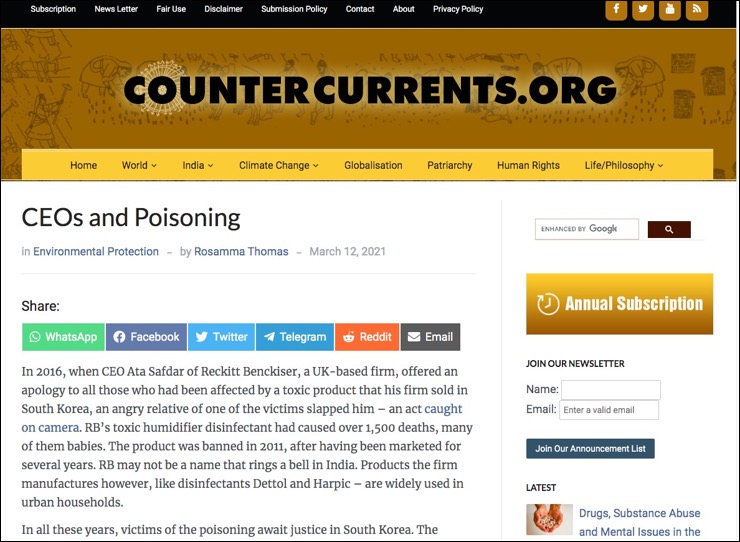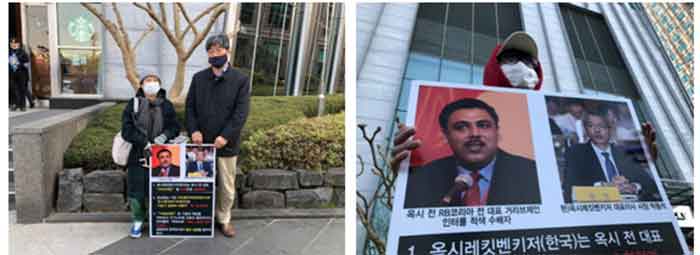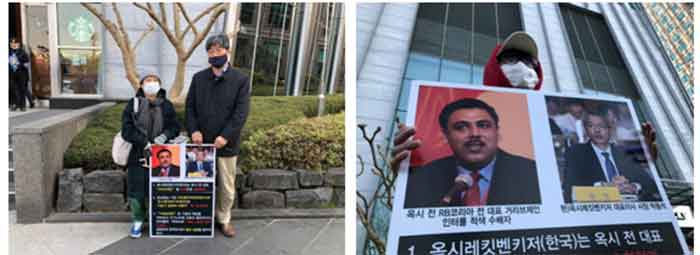CEOs and Poisoning
[가습기살균제 옥시RB와 LG화학의 인도 가스누출사고에 관한 인도 영자언론 counter currents의 2021년3월12일자 기사를 소개합니다, 밑에 한글번역을 붙입니다. 참고하세요 ]
CEOs and Poisoning
counter currents.org
https://countercurrents.org/2021/03/ceos-and-poisoning/
2021.3.12 Rosamma Thomas
In 2016, when CEO Ata Safdar of Reckitt Benckiser, a UK-based firm, offered an apology to all those who had been affected by a toxic product that his firm sold in South Korea, an angry relative of one of the victims slapped him – an act caught on camera. RB’s toxic humidifier disinfectant had caused over 1,500 deaths, many of them babies. The product was banned in 2011, after having been marketed for several years. RB may not be a name that rings a bell in India. Products the firm manufactures however, like disinfectants Dettol and Harpic – are widely used in urban households.
In all these years, victims of the poisoning await justice in South Korea. The topmost officials of the firm who are wanted by South Korean prosecutors have not complied with the law. Humidifiers are never used in India – in South Korea and other cold countries as indoor moisture is reduced in winter, a device is used to keep moisture levels in rooms pleasant. This device sprays water into the air. To keep the water in the device free of bacteria and fungi, a disinfectant was added – that was the source of the poisoning, it was later discovered.
Among those wanted by prosecutors for the deaths from humidifier disinfectant poisoning is Indian Gaurav Jain, who served as CEO of RB in South Korea at the time the poisonous substance was sold. Jain has flatly refused to join the process of investigation.
“We protect, heal and nurture in the relentless pursuit of a cleaner and healthier world,” says the website of RB. This bid for an unnatural ‘cleanliness’, however, endangers not just bacteria and fungi but human life as well. Oxy Humidifier Sanitizer (HS), which this firm sold, took at least 1,500 lives over several years. Over 7,000 people were affected, according to the website ‘Healthrelief”. (Available here in Korean: https://www.healthrelief.or.kr/home/content/stats01/view.do)
The disinfectant was first introduced in 1994. A local firm called Oxy which manufactured it was acquired by RB in 2001. The humidifier disinfectant caused tiny nano particles to be released into the air, inducing lung disease.
Eunjoo Ahn, among those affected, said, “I was a professional volleyball player. I used Oxy ‘Ssakssak’ at home and grew short of breath. It grew so bad in 2008 that I collapsed. As my condition worsened, I needed lung transplant – I have been through surgery twice, in 2015 and 2020. Despite long spells in hospital, the breathing difficulties continue. RB destroyed my life and my family. My wife left. My two children now do not have the protection of a mother.”
Domyung Paek, professor of public health at Seoul National University said, “Humidifiers pump water droplets into the air and nothing should be added to the water. Regardless of whether it was ignorance, negligence or greed, RB’s decision to sell such products should be reviewed and judged, so this kind of disaster is never repeated anywhere in the world.”
Although RB has acknowledged “how tragic this situation is” and has vowed to work towards putting things right in South Korea, it has done little to abide by the law and stand trial.
At the time of the introduction of the humidifier for the first time in the 1990s, there were few tests to examine whether it was safe. The market for the product grew rapidly, and as many as 43 different South Korean and international brands were marketing these disinfectants by the year 2011.
Between 2006 and 2011, there was an outbreak of severe lung disease among children in South Korea – a probe into the probable cause of the disease led to the discovery of the toxicity of Polyhexamethylene guanidine (PHMG) which was used for its potent action against bacteria and fungi in humidifiers. When it is inhaled, however, it causes harm to human lungs too, especially children’s lungs, inducing pulmonary fibrosis. It was clear that the children’s health was affected by an “environmentally induced disorder”.
By the spring of 2011, doctors alerted authorities to several cases of atypical lung injury among young, pregnant women. An environmental threat was suspected. Studies showed that regular addition of disinfectant to the water tanks of room humidifiers significantly increased the risk of such lung disease. Infants were more susceptible to lung damage through it, and the disease spiked in winter, when humidifiers were more commonly used.
Other toxic chemicals Chloromethyl isothiazolinon (CMIT/MIT), Benzylammonium chloride (BKC) and Oligo (2) ethoxyethoxyethyl guanidine hydrochloride (PGH) were also found in the humidifier disinfectants. One brand held about 80 per cent of the market share for these products in South Korea, RB.
Experiments showed that rats exposed to these disinfectants died in seven weeks. In the winter of 2011, the South Korean government banned the use of the humidifier disinfectants. Even though RB has accepted the enormity of the problem and apologized, its top management has so far dodged the law.
Research into this poisoning was conducted in 2013 by a team of scientists attached to the Korean Centre for Disease Control, whose work was later published under the title ‘Nationwide Study of Humidifier Disinfectant Lung Injury in South Korea, 1994-2011’.
The scientists traced 433 cases; 307 of the affected persons studied were alive, they noted also cases of 126 who had died and spoke with families of the deceased. The earliest case they found was from 2002, and they noted in their paper that the cases then “increased exponentially” until 2011. Frequency of use of the disinfectant, and the quantity of it used each time had a clear link with the severity of the impact on the lungs.
While the infants who were exposed had the highest mortality rate, the adults exposed too had long-term health effects that continue to be monitored. There was also improved lung function in some of the affected though it not yet clearly understood why in some cases the damage could be reversed.
South Korea government studies established that the humidifier disinfectants caused about 10 different health impacts, from severe respiratory disease to fetal damage. As of November 2020, over 6,900 cases were registered, and over 1,570 have died. Over 80% of all registered cases have used RB products. (Source – https://www.healthrelief.or.kr/home/content/stats01/view.do)
In 2015, United Nations Special Rapporteur for Toxics, Mr Baskut Tuncak investigated this matter and noted that RB held 80 per cent of the market share for this product in South Korea, but failed to ensure safety.
Health concerns: Product not sold in Europe
What was striking was that the toxic product was not sold in Europe, on account of safety concerns. With regulations being rather more lax in South Korea, the product was allowed to affect the population.
UN’s Tuncak noted the need for a comprehensive global framework to protect human health from a toxic environment, and observed also that injustices resulted from divergent standards adopted in different parts of the world.
Even as the then CEO of RB has escaped the law, other officials who served RB in South Korea at the time are currently serving out jail sentences. Even in November 2019, South Korean officials involved in the probe sought to meet Jain in India; he refused. In November 2020, a small group of victims protested, carrying photographs of Jain and seeking justice.
[Humidifier Disinfectant Victim outside RB headquarters in Seoul demanding investigation against Gaurav Jain on November 26, 2020]
LG Chemical: Korean nationals wanted in India for Styrene gas leak deaths of May 2020
Jain is not the only CEO to have escaped the law. Korean national Rho Kuk-rae is wanted by Indian law enforcement agencies. He was the head of the support team of LG Chemical from where the leak of toxic styrene gas on May 7, 2020 caused 15 deaths at Andhra Pradesh’s Vishakapatnam. Rho Kuk-rae returned home after this tragedy; Shin Hak-cheol, CEO of LG Chemical, never visited India after that tragedy.
A high power government committee submitted its probe report in this case in July 2020, blaming the firm for negligence that caused the leak. Civil society groups have called for the South Korean firm’s management to be held responsible, but no action has yet been taken against them.
Countercurrents wrote an email to RB seeking a response on why Gaurav Jain was not cooperating with prosecutors in South Korea. No response was received. Activist Yeyong Choi, director of Asian Citizens’ Centre for Environment and Health, who has also served as a member of the government team that investigated RB, said, “RB should have Gaurav Jain attend the South Korean government’s investigation and express sincere apology. Otherwise, we will organize a campaign to boycott RB products.”
Rosamma Thomas is a freelance journalist
CEOs and Poisoning [기업총수들과 독살]
counter currents.org
https://countercurrents.org/2021/03/ceos-and-poisoning/
2021.3.12 Rosamma Thomas
2016년 영국계 기업인 레킷벤키저의 애타 사프다 대표가 자신의 회사가 한국에서 판매한 유독성 제품 때문에 피해를 본 모든 사람에게 사과하자, 피해자 중 한 명의 성난 친척이 뺨을 때리는 등 카메라에 잡힌 행동이다. RB의 유독성 가습기 살균제는 1,500명 이상의 사망자를 냈으며, 그들 중 많은 수가 아기들을 죽였다. 이 제품은 몇 년 동안 시판된 후 2011년에 금지되었다. RB는 인도에서 종을 울리는 이름이 아닐지도 모른다. 그러나 소독제 데톨과 하피크 같은 이 회사가 제조하는 제품은 도시 가정에서 널리 사용되고 있다.
이 모든 해 동안, 독살 피해자들은 한국에서 정의를 기다리고 있다. 한국 검찰의 수배를 받고 있는 이 회사의 고위 간부들은 이 법을 지키지 않았다. 가습기는 인도에서는 절대 사용되지 않습니다. 한국과 다른 추운 나라에서는 겨울에 실내 수분이 감소하기 때문에 실내의 수분 수준을 쾌적하게 유지하는 장치를 사용합니다. 이 장치는 공기 중에 물을 분사한다. 장치의 물을 박테리아와 곰팡이로부터 보호하기 위해, 독극물의 근원인 소독약이 추가되었고, 나중에 발견되었다.
가습기 살균제 중독 사망사고로 검찰이 수배 중인 이들 중에는 독극물 판매 당시 한국에서 RB 대표를 지낸 인도 가우랍 자인이 포함돼 있다. Jain은 조사 과정에 참여하기를 단호히 거절했다.
"우리는 더 깨끗하고 건강한 세상을 끊임없이 추구하면서 보호, 치유 및 육성합니다."라고 RB의 웹사이트는 말합니다. 그러나 이 비정상적인 '청결성'을 위한 시도는 박테리아와 곰팡이뿐만 아니라 인간의 생명까지도 위협한다. 이 회사가 판매한 옥시 가습기 세정제(HS)는 수년 동안 최소 1500명의 생명을 앗아갔다. 웹사이트 '헬스 릴리프'에 따르면 7,000명 이상이 피해를 입었다. (여기 한국어: https://www.healthrelief.or.kr/home/content/stats01/view.do)
그 소독약은 1994년에 처음 도입되었다. 그것을 제조한 옥시라는 국내 회사가 2001년에 RB에 인수되었다. 가습기 살균제는 작은 나노 입자가 공기 중으로 방출돼 폐질환을 유발했다.
안은주 선수는 프로배구 선수였다. 나는 집에서 옥시 '삭삭'을 썼는데 숨이 가빠졌어. 2008년에 너무 심해서 쓰러졌어요. 상태가 악화됨에 따라 폐 이식이 필요하게 되었습니다. 2015년과 2020년에 두 차례 수술을 받은 적이 있습니다. 병원에서 오랜 기간 동안 계속 호흡곤란 증세가 나타난다. RB는 내 삶과 가족을 파괴했다. 남편이 떠났어요. 내 두 아이는 이제 부모의 보호를 받지 못합니다."
도명백 서울대 공중보건학과 교수는 가습기는 공기 중에 물방울을 뿜어내는데 물 속에 아무것도 첨가해서는 안 된다. 무지와 과실, 탐욕과 무관하게 RB의 이런 제품 판매 결정을 검토하고 판단해야 하기 때문에 이런 참사는 세계 어디에서도 결코 되풀이되지 않는다."
RB는 "이 상황이 얼마나 비극적인가"를 인정하고 한국에서 상황을 바로잡기 위해 노력하겠다고 다짐했지만, 법을 준수하고 재판을 받는 데는 별 도움이 되지 않았다.
1990년대 들어 가습기가 처음 도입될 당시에는 안전 여부를 검사하는 테스트가 거의 없었다. 이 제품의 시장은 급속히 성장했고, 2011년까지 무려 43개의 국내외 브랜드들이 이 살균제를 마케팅하고 있었다.
2006년과 2011년 사이에, 한국 어린이들 사이에서 심각한 폐질환이 발생했는데, 이는 질병의 가능한 원인에 대한 조사로 인해 가습기의 박테리아와 곰팡이에 대한 강력한 작용에 사용된 폴리헥사메틸렌과니딘(PHMG)의 독성이 발견되었다. 하지만 흡입하면 폐에 해를 끼쳐 폐섬유화를 유발한다. 아이들의 건강이 "환경적으로 유발된 장애"에 의해 영향을 받은 것은 분명했다.
2011년 봄, 의사들은 정부 당국에 젊은 임산부들 사이에서 전형적인 폐 부상의 몇 가지 사례를 알렸다. 환경 위협이 의심되었다. 연구에 따르면 정기적으로 방 가습기의 물탱크에 소독제를 첨가하면 폐질환의 위험이 크게 높아진 것으로 나타났다. 유아는 이를 통해 폐손상에 더 취약했고 가습기를 더 많이 사용하는 겨울철에 질병이 급증했다.
가습기 살균제에서도 다른 독성 화학물질인 클로로메틸이소티아졸리논(CMIT/MIT), 염화벤질아모늄(BKC), 에톡시에틸구아니딘(PGH)이 검출됐다. 한 브랜드는 한국에서 이들 제품의 시장점유율 약 80%를 점유하고 있다.
실험 결과 이 소독제에 노출된 쥐들은 7주 만에 죽었습니다. 2011년 겨울, 한국 정부는 가습기 살균제의 사용을 금지했다. 비록 RB가 문제의 심각성을 인정하고 사과했지만, 그것의 최고 경영진은 지금까지 법을 회피해왔다.
이 중독에 대한 연구는 2013년 한국질병관리센터 소속 과학자들에 의해 수행되었으며, 이후 '대한민국의 가습기 살균제 폐손상 전국 연구, 1994-2011'이라는 제목으로 연구되었다.
과학자들은 433명의 환자를 추적했는데, 조사 대상자 중 307명이 생존해 있으며, 사망한 126명의 환자도 사망했으며 사망자 가족들과 대화를 나눴다고 밝혔다. 그들이 발견한 최초의 사례는 2002년이며, 그들은 논문에서 그 사례가 2011년까지 "지수적으로 증가"했다고 언급했다. 소독제의 사용 빈도와 매번 사용되는 수량은 폐에 미치는 영향의 심각성과 분명한 연관성을 가지고 있었다.
피폭된 유아 사망률이 가장 높았지만, 피폭된 성인들도 장기간의 건강 영향을 지속적으로 관찰하고 있다. 일부 환자들의 폐 기능 또한 개선되었지만 일부의 경우 손상이 반전될 수 있는 이유를 아직 명확하게 이해하지 못했다.
한국 정부 연구는 가습기 살균제가 심각한 호흡기 질환에서 태아 손상까지 약 10가지 건강상의 영향을 끼친다는 것을 입증했다. 2020년 11월 현재 6,900명 이상이 등록되었으며 1,570명 이상이 사망했다. 등록된 모든 케이스의 80% 이상이 RB 제품을 사용해 왔습니다. (출처 – https://www.healthrelief.or.kr/home/content/stats01/view.do)
2015년, 유엔 독성물질 특별보고관인 바스켓 툰콕씨는 이 문제를 조사했고, RB가 한국에서 이 제품의 시장점유율 80%를 차지했지만, 안전성을 확보하지는 못했다고 언급했다.
건강 문제: 유럽에서 판매되지 않는 제품
눈에 띄는 것은 이 유독성 제품이 안전을 우려해 유럽에서 판매되지 않았다는 점이다. 한국에서는 규제가 다소 느슨해짐에 따라, 그 제품이 인구에 영향을 줄 수 있게 되었다.
UN의 Tuncak은 독성 환경으로부터 인간의 건강을 보호하기 위한 포괄적인 글로벌 프레임워크의 필요성에 주목했으며, 또한 세계 여러 지역에서 채택된 다양한 표준들 때문에 부정이 발생한다고 관찰했다.
당시 RB 대표가 법망을 빠져나갔음에도 불구하고 당시 한국에서 RB를 모셨던 다른 간부들은 현재 실형을 살고 있다. 심지어 2019년 11월, 조사에 참여한 한국 관계자들은 인도에서 자인을 만나려고 했지만, 그는 거절했다. 2020년 11월, 소수의 피해자 집단이 자인의 사진을 싣고 정의를 찾는 등 시위를 벌였다.
[가습기 살균제 피해자, 2020년 11월 26일 서울 RB 본사 밖에서 가습기 살균제 피해자, 가우라브 제인에 대한 조사 요구]
LG화학: 2020년 5월 스티렌 가스 누출 사망사고로 인도 내 한국인 수배자
법망을 빠져나간 CEO는 제인뿐만이 아니다. 한국 국적의 노국래는 인도 사법기관의 수배를 받고 있다. 그는 2020년 5월 7일 안드라프라데시 비샤카파타남에서 유독 스티렌 가스가 누출돼 15명이 사망한 LG화학 지원팀장을 맡았다. 노국래는 참사후 집으로 돌아가버렸고, 신학철 LG화학 사장은 이 비극 이후 인도를 방문한 적이 없다.
정부고위위원회는 2020년 7월 이 사건의 조사보고서를 제출하면서 유출의 원인이 된 회사의 과실을 비난했다. 시민사회단체들은 한국 기업의 경영진에 책임을 물을 것을 요구했지만, 아직 그들에 대한 어떠한 조치도 취해지지 않았다.
카운터커런츠는 왜 가우라브 자인이 한국 검찰에 협조하지 않는지 답변을 구하는 이메일을 RB에 보냈다. 수신된 응답이 없습니다. RB를 조사한 정부 측 인사로 활동해온 최예용 아시아환경보건센터 소장은 "RB가 한국 정부 조사에 가우라브 제인을 출석시켜 진심 어린 사과를 해야 한다"고 말했다. 그렇지 않으면 RB 제품 불매운동을 벌이겠다고 말했다.






